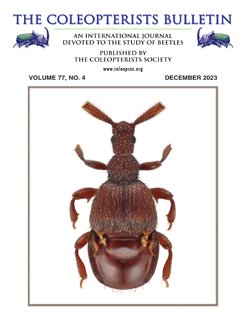Despite the high rates of biodiversity and endemism in Inter-Andean Dry Tropical Forests (IADTF), part of the endangered Seasonally Dry Tropical Forests (SDTF), the study of insect biodiversity in this habitat has been neglected. This study aimed to address the knowledge gap regarding beetle diversity at an Ecuadorian IADTF, specifically at Bosque Protector Jerusalém (BPJ). A rapid survey collected 568 beetle specimens representing 66 species, with Chrysomelidae, Curculionidae, and Coccinellidae as the most abundant families. The Simpson index revealed high species diversity, with five dominant species contributing significantly to abundance. The presence of singletons and doubletons indicated a rich and complex community structure. The species accumulation curve did not reach an asymptote, and the Chao 1 index estimated a total of 105 beetle species at BPJ, suggesting further undiscovered diversity. Several potentially new taxa were found, including a new genus country record for Psomus Casey (Curculionidae), highlighting the need for further taxonomic research in this under-sampled ecosystem. Additionally, evidence of introduced species emphasizes the influence of the peri-urban landscape surrounding BPJ. This study provides a baseline for future biodiversity assessments and conservation initiatives, emphasizing the importance of studying sensitive taxa like beetles to understand and protect the vulnerable IADTF ecosystem.
A pesar de la alta biodiversidad y endemismo en el Bosque Seco Tropical Interandino (BSTI), parte del Bosque Seco Tropical Estacional (BSTE), el estudio de la entomofauna en éste hábitat ha sido relegado. Este estudio tuvo como objetivo reducir la brecha de conocimiento respecto a la diversidad de escarabajos en un BSTI ecuatoriano, el Bosque Protector Jerusalém (BPJ). El muestreo reveló 568 especímenes, representando 66 especies, siendo Chrysomelidae, Curculionidae y Coccinelidae las familias más abundantes. El índice de Simpson reveló una alta diversidad, con cinco especies dominantes que contribuyeron significativamente a la abundancia. La presencia de “singletons” y “doubletons” dio indicios de una comunidad rica y compleja. La curva de acumulación de especies no alcanzó una asíntota, y el índice Chao 1 estimó un total de 105 especies, sugiriendo una mayor diversidad por descubrir. Se encontraron varios taxones potencialmente nuevos, incluido un nuevo registro de género para el país para Psomus Casey (Curculionidae), acentuando la necesidad de más investigaciones taxonómicas en este ecosistema. Además, se hallaron algunas especies introducidas, resaltando la influencia del paisaje periurbano circundante. Este estudio proporciona una base para futuros estudios e iniciativas de conservación, además señala la importancia de estudiar taxones sensibles como los escarabajos para comprender y proteger este ecosistema amenazado.






